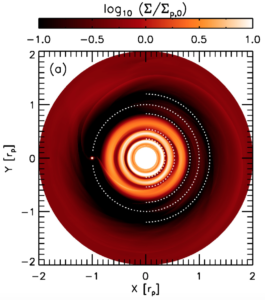
Recent high-resolution observations have imaged fascinating details of protoplanetary disks, some of which are shown above (left: HL Tau, ALMA Partnership et al. 2015; middle: TW Hya, Andrews et al. 2016, right: HD 163296, Isella et al. 2016). These data show surprisingly concentric, multiple rings and gaps in thermal emission. What creates them?
Unfortunately, we don’t have the answer yet. Some possibilities are gravitational interaction between (proto)planet(s) and the disk, rapid changes in dust properties between the rings and gaps, and hydrodynamic/magnetohydrodynamic instabilities that can create ripples in the disk and trap solid particles.
When it comes to planets, we would naturally think that we will need as many planets as the number of gaps — one planet per gap. However, what I’m going to show is that we may not need that many planets to explain all the gaps. In fact, one planet can create multiple gaps and rings!

The above figure shows a snapshot of a numerical simulation with a Jupiter-mass planet (the little bright dot at X=-1, Y=0) in the disk around a solar-mass star at the center. As shown, the planet opens a deep gap around its orbit, but also additional gaps interior to its orbit — see also an animated version of this figure here.
So what’s happening? It’s spiral arms what make this possible. Planets launch spiral arms in the underlying disk; it’s like a boat leaving wakes behind. When they steepen into shocks spiral arms essentially produce some sort of “viscosity” which redistributes disk gas, opening gaps. Interestingly, planets can excite more than one spiral arm (if you want to know how, see here). In the example above, the planet excites one spiral arm exterior to its orbit and three spiral arms interior to its orbit. Each dotted semi-circle indicates the radius at which a spiral arm steepens into a shock. See the gaps open where spiral arms shock the disk?
Now go back to the figure on the top and guess where planets are sitting in the disks!
related article:
On the formation of multiple concentric rings and gaps in protoplanetary disks
